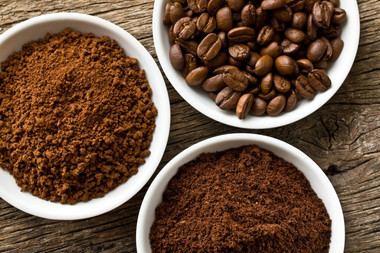How To Grind Coffee Beans At Home & Why Freshness Matters
Posted by Mark Bentham, The Coffee Man on 17th Dec 2018
Why you should always use only freshly roasted, whole coffee beans.
Coffee Beans are natural food products, hopefully organic, and hold live nutrients and characteristics. Similar to any natural whole food product, they have an expiry date and a best use by date. The reason there is a date of expiry on most (good) coffee beans is that once the coffee bean is roasted, it starts to go stale immediately.
This is why you will always get a better quality coffee at home if you buy direct from a roaster, get your beans delivered whole, and grind coffee beans at home only as you need them.
Freshness Counts.
Let me explain more about the expiration of fresh coffee, what actually happens and why you should grind coffee beans at home.
1. Carbon Dioxide Release.
Once the beans have been roasted, gasses including carbon dioxide are produced inside the bean. This and other gasses that are trapped inside the bean start to release from within the cell walls. This process called degassing occurs very quickly and as it occurs it draws out the flavours and lessens the quality of the beans.
2. Oxygenation Happens.
This is the process where one or more electrons move from one compound to another after being exposed to oxygen. This results in new compounds and therefore different molecular structure. By keeping the coffee beans away from oxygen you will keep the integrity of the beans intact for longer.
3. Oils and Aromatics Get Lost.
When oils and aromatics that naturally are present in the bean are exposed to carbon dioxide and other gasses, these aromatics and oils bean dissipate and move away from the bean, lessening the impact of the desired end result and flavour.
Having coffee beans on hand within one week of roasting means you can enjoy a month – 2 months of great quality coffee before the flavour starts to be compromised. This is the ideal time frame in which the better flavours are present and the undesirable flavours are minimised.
Grind coffee beans at home only as you use the coffee.
When you receive your freshly roasted beans, keep them cool and dark… and no cryogenics needed - you're only keeping the beans for a month or so anyway, so keep them at a stable temperature of around 20-25 degrees and they will maintain all their beautiful characteristics for as long as possible.
Breaking anything into smaller pieces, from iron to coffee beans, exposes it to air and causes more oxidisation. That's a fancy way of saying ‘air is the enemy'. Just like your whole coffee beans are susceptible going stale, so too is ground coffee. Only ground coffee does it much, much quicker because it has more surface area exposed to the elements.
Literally, within minutes of grinding coffee, it starts to stale. Obviously, if you're trying to brew the best-cup-of-coffee-you-have-ever-had-in-all-your-born-days then starting with stale beans isn't going to get you there. Keep it fresh. Grind it just before you brew and grind only the amount you are going to use right away.
Not all grinders are created equal.
The mini food processor type grinders, or blender attachments, you can get from the supermarket tends to get a bit warm and also tend to grind beans a bit unevenly – like fine Pindan dust with big bits sticking out of it everywhere. This matters because the grind size and consistency is important to your brewing style.
Ceramic burr grinders are the gold standard for coffee connoisseurs because they make a nice even grind and because they don't heat up when used. Thus not affecting the delicate beans with heat.
Try something small and portable, lightweight, and with adjustable ceramic burrs, so it is suitable for everything from French Press to Turkish Coffee. It will grind those beautiful beans fresh, and exactly to the right consistency.
Check out our grinders available online here.

On most grinders, the grind is set from completely closed based on the number of clicks you hear when the dial is turned anti-clockwise. You will need to adjust the grind to your personal taste to some degree, but a rough guide is:
The below is an indicator of fine (1) to coarse (6) grinding settings;
1 click – Turkish Coffee, or the Ibrik
2 clicks – Portable Espresso Maker
3 clicks – Stovetop (Italian) Espresso, Home Espresso Maker
4 clicks – Immersion & Pressure Method
5 clicks –Filter Coffee
6 clicks – French Press (The Plunger) and Cold Brew
You may need to (and are of course welcome to!) adjust the grind to your personal taste.
In general: the finer the grind, the shorter the brew time. If you're finding your coffee bitter, you may need to use a coarser grind.
Check out our Grind Guide here
– for a free download if you are reading this blog now! Yip Yip!
Now that you understand how the beautiful coffee bean, being an alive, whole food, actually works, you will never reach for the discount bags of beans in the supermarket again! Check out our selection of freshly roasted beans here – you order, we roast, we ship to your doorstep.
Now order some awesome coffee and get grinding!
